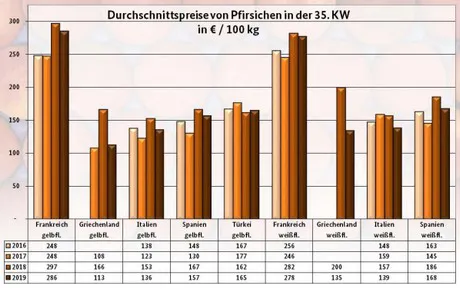The markets were sufficiently supplied with the predominant Spanish and Italian batches of peaches and nectarines. The shops could have run more smoothly, but some fruits were qualitatively below par. In addition, demand was weak at certain points. Promotions to drive the sales, however, did not succeed consistently. French products had good organoleptic properties and were able to keep their previous high prices.

Greek shipments participated in a complementary trade frame, but were already missing in some places, indicating the early completion of the season. Turkish imports rounded off the range in small quantities, and thanks to continuous sales they usually cost as much as before. Only in Berlin the demand generally increased, so that sales were quite fast overall. There, on Thursday, the French offers became cheaper due to their expanded presence. Platerinas and Paraguayos cost between €1.50 and €1.70 per kg and gained in importance in the capital.
Apples
From Germany came various varieties, in particular Elstar and Delbarestivale and more recently Tenroy and Holsteiner Cox. Demand was not always great' even in the weekend it was below expectations.
Pears
In general, demand could be met without difficulty. Prices kept on changing, but they did not show a clear trend.
Table grapes
Italian batches obviously dominated, but still had to share the market. Michele Palieri, Victoria and Crimson Seedless saw the best trade.
Apricots
The season ended with limited batches, generally declining organoleptic characteristics, a low demand and price volatility.
Plums
The range of goods was quite rich. The basis was formed by Stanleys from Eastern Europe as well as Cacak's Schöne, Cacak's Fruchtbare and Top from the inland. The supplies from Germany intensified.
Lemons
The high temperatures had an impact on demand, which steadily decreased. Only by reducing the supply could lowering the prices be avoided.
Bananas
Due to seasonal reasons, marketing continued to be fairly quiet. As a rule, the access from the ripeners correlated sufficiently with the outflow of goods. As a result, most prices remained at the same levels.
Cauliflower
Germany dominated events ahead of Belgium and Poland. The deliveries grew immensely, primarily the Belgian batches took up more space. In qualitative terms, there was little reason for criticism.
Lettuce
Lettuce came mainly from the inland. Supply had not changed significantly. But demand picked up, so prices often went up accordingly.
Cucumbers
For cucumbers, German, Belgian and Dutch offers were available at the markets. Availability grew a bit. Demand was not particularly friendly.
Tomatoes
Dutch and Belgian deliveries predominated. Due to the circumstances and a reduced supply, prices tended to go up. However, this had a negative effect on sales options, which were noticeably limited.
Sweet peppers
Dutch goods dominated the events. Supply had not changed significantly. The demand could be satisfied without difficulty. Nevertheless, prices rose frequently.
